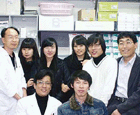|
|
식품생화학 문제 풀어보실래요? (1) 생체 내 에너지 대사는 ATP가 ‘biological cash’라고 하여 가장 중요한 물질이다. 다음의 중심단어(key words)를 반드시 사용(적색 또는 box로 표기)하여 왜 ATP가 생체 에너지 대사에서 중요한 물질인지에 대하여 설명하시오. Key words: solar energy, evolution, ribozyme, photosynthesis, starch, glucose, glycolysis, TCA cycle, oxidative phosphorylation, ATP, ADP, AMP, -7.3 kcal/mol, coupled reactions 다음 각 문제를 읽고 O, X를 기입하시오. X의 경우에는 틀린 곳을 고치시오. 각2점 (1) Uncoupling protein은 whitening effect와 관련이 있다 ( ) (2) Hypoxia-inducible transcription factor-1은 obesity와 밀접한 관련이 있는 분자이다 ( ) (3) Energy charge가 높을 때에는 pyruvate dehydrogenase는 swich on의 상태로 된다 ( ) (4) Reductant가 electron을 받으면 oxidant의 상태로 된다 ( ) (5) Electron gradient가 ATP의 driving force가 된다 ( ) (6) Glucose 1-phosphate hydrogenase가 ROS의 defense에 주요한 역할을 한다 ( ) (7) Hexokinase는 1분자의 ATP 존재 하에서 Mg나 Mn++가 이온의 도움을 받아서 가역적 반응을 촉진시킨다 ( ) (8) Pentose phosphate pathway는 지방산 생합성과 연관되어 있다 ( ) (9) ATP, ADP, AMP의 level은 생체 내에서 매우 잘 정교하게 유지되는데 각 농도 중 ADP의 농도가 가장 높다 ( ) Write the best answer to each question. 각5점 (11) During glucose metabolism, ( ) is used in reductive biosynthesis, whereas ribose 5-phosphate is used in the synthesis of RNA, DNA, and nucleotide coenzymes. (12) What are the cellular defense strategies against oxidative damage by reactive oxygen species? Chief among them is the enzyme ( ). This enzyme scavenges superoxide radicals by catalyzing the conversion of two of these radicals into hydrogen peroxide and molecular oxygen. (13) ( ) is the process in which ATP is formed as a result of the transfer of electrons from NADH or FADH2 to oxygen by a series of electron carriers. 다음을 번역하시오. 7점 (14) About 30 molecules of ATP are generated when a molecule of glucose is completely oxidized to carbon dioxide and water. Electron transport is normally tightly coupled to phosphorylation. NADH and FADH2 are oxidized only if ADP is simultaneously phosphorylated to ATP, a form of regulation called acceptor or respiratory control. Proteins have been identified that uncouple electron transport and ATP synthesis for the generation of heat. Uncouplers such as DNP also can disrupt this coupling; they dissipate the proton gradient by carrying protons across the inner mitochondrial membrane. 아래 15-17번은 키워드를 사용하거나 그림을 그려서 상세하게 원리/가설에 근거하여 설명하시오 (각 문항은 응시자 중 최고점을 만점으로 하여 상대적으로 채점함). 각20점 (15) Pentose phosphate pathway에서 일어날 수 있는 대사흐름도를 그려서 설명해 보시오(ATP, NADPH, DNA replication을 가정하여). (16) Glycerol 3-phosphate shuttle을 통하여 전자전달계로 산화되는 과정이 shuttle을 통하지 않고 정상적인 전자전달계를 통하는 것과 비교하여 어떤 다른 점이 있는지를 glucose 1분자가 대사된다고 가정하고 전체적인 metabolism map을 설명하시오(ATP 생성 측면을 설명). (17) TCA cycle에서 anaplerotic reaction이 일어난다면 어떤 시기에 일어나는가? (단, 낮은 농도의 ATP 준위에서 glucose와 fatty acid로부터 acetyl CoA를 거쳐서 TCA cycle이 진행되는 경우와 비교하여 설명하시오) 다음 각 문제를 읽고 O, X를 기입하시오. X의 경우에는 틀린 곳을 고치시오. 각2점 (1) Uncoupling protein은 whitening effect와 관련이 있다 ( ) (2) Hypoxia-inducible transcription factor-1은 obesity와 밀접한 관련이 있는 분자이다 ( ) (3) Energy charge가 높을 때에는 pyruvate dehydrogenase는 swich on의 상태로 된다 ( ) (4) Reductant가 electron을 받으면 oxidant의 상태로 된다 ( ) (5) Electron gradient가 ATP의 driving force가 된다 ( ) (6) Glucose 1-phosphate hydrogenase가 ROS의 defense에 주요한 역할을 한다 ( ) (7) Pentose phosphate pathway는 지방산 생합성과 연관되어 있다 ( ) (8) Apoptosis는 암세포에서 특이적으로 발현되며 caspase-3에 의하여 세포내 단백질이 분해된다 ( ) Write the best answer to each question. 각5점 (9) During glucose metabolism, ( ) is used in reductive biosynthesis, whereas ribose 5-phosphate is used in the synthesis of RNA, DNA, and nucleotide coenzymes. (10) What are the cellular defense strategies against oxidative damage by reactive oxygen species? Chief among them is the enzyme ( ). This enzyme scavenges superoxide radicals by catalyzing the conversion of two of these radicals into hydrogen peroxide and molecular oxygen. (11) ( ) is the process in which ATP is formed as a result of the transfer of electrons from NADH or FADH2 to oxygen by a series of electron carriers. (2) 생체 내 에너지 대사는 ATP가 ‘biological cash’라고 하여 가장 중요한 물질이다. 다음의 중심단어(key words)를 반드시 사용(적색 또는 box로 표기)하여 왜 ATP가 생체 에너지 대사에서 중요한 물질인지에 대하여 설명하시오. Key words: solar energy, evolution, ribozyme, photosynthesis, starch, glucose, glycolysis, TCA cycle, oxidative phosphorylation, ATP, ADP, AMP, -7.3 kcal/mol, coupled reactions (3) 2020년 11월 11일 오전9시 현재, 미국 NCBI의 PubMed에서 논문검색을 수행한 바에 의하면 ERK, p38, JNK란 단어 3개가 동시에 abstract에 들어 있는 과학논문은 6,612개나 검색되었다(2008년 10월 6일 오전9시는 2,300여개이었으므로, 12년 만에 2.87배 증가!!!). i) 위 3개의 단어(ERK, p38, JNK)를 사용하여 한 개의 세포(동물세포에 국한) 내로 신호가 전달되는 과정을 그림으로 그려서 signal (ligand)--> receptor --> G-coupled proteins --> MAPKs --> transcription factors로 신호(signal)가 전달되는 과정을 그리시오. ii) 만약 이 신호(signal)가 antigen으로서 transcription factor에 전달되고 이 후에 일어나는 일련의 antibody(또는 proteins) 생성과정을 central dogma에 근거하여 자세하게 기술하여 보시오. (4) Pentose phosphate pathway에서 일어날 수 있는 대사흐름도를 4가지의 모드로 나누어 그림으로 설명해 보시오(ATP, NADPH, DNA replication을 가정하여). (5) Glycerol 3-phosphate shuttle을 통하여 전자전달계로 산화되는 과정이 shuttle을 통하지 않고 정상적인 전자전달계를 통하는 것과 비교하여 어떤 다른 점이 있는지를 glucose 1분자가 대사된다고 가정하고 전체적인 metabolic map을 설명하시오(ATP 생성 측면과 이의 조절측면을 설명). (6) TCA cycle에서 anaplerotic reaction이 일어난다면 어떤 시기에 일어나는가? (단, 낮은 농도의 ATP 준위에서 glucose와 fatty acid로부터 acetyl CoA를 거쳐서 TCA cycle이 진행되는 경우와 비교하여 그림으로 설명). (7) Glycogen의 생합성과 분해를 구분하여 서술하고, liver와 muscle에서 glycogen의 생물학적 의의를 설명하시오. (8) Glycolysis 과정의 대사는 3군데 중 2군데가 가장 결정적인 영향을 미치는 조절포인트인데, TCA cycle도 그려서 이의 조절기전을 설명하여 보시오. (9) Uncoupling protein의 생물학적 의의는 무엇인지 그림을 그려서 설명해 보시오. (10) 정상세포와 암세포는 Apoptosis의 현상에서는 상반되는 결과를 나타낸다. 이를 어떻게 설명할 것인가? |


| 
|

 HOME
HOME







 전체글 보기
전체글 보기  자유게시판
자유게시판

















